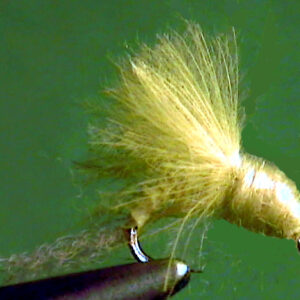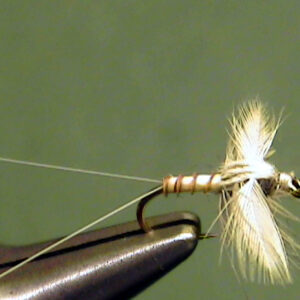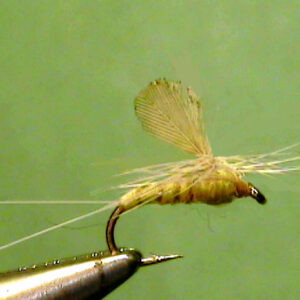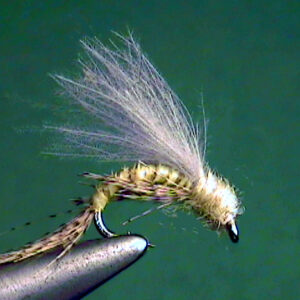Hook Size: 14
The Perfect Fly Pale Evening Dun nymph is a trout fly that imitates the mayfly in the nymphal stage of life. Pale Evening Dun nymphs are clinger nymphs. They stay under the crevice of rocks and crawl around on the bottom to feed or when they hatch and should be fished on or near the bottom during the hatch.
Pale Evening Duns can be an important mayfly to imitate on some of the streams
in the Western United States. It is not usually a huge hatch but on the streams
where it does exist it is important because if hatches at a time there are few other
mayflies hatching. Most of the stonefly hatches on the stream it exist in have
usually already occurred and there may not even be many caddsflies on the
water at the time the Pale Evening Duns hatch.
The Pale Evening Dun is in the Heptagenia group of mayflies. The Heptagenia
solitaria species that exist in the West is usually called the Gray Fox. The other
species, mainly the elegantulata species, are usually called Pale Evening Duns.
Although they almost never hatch in prolific quantities, they may be found in just
about all of the streams at all elevations. In Yellowstone National Park for
instance, we know they are found in the Yellowstone, Lewis and Gardner Rivers
but we have not checked specifically for the mayflies in other stream samples we
have taken. There are probably even more streams.
Pale Evening Dun Nymphs:
Heptagenia nymphs are clingers. They look much like the other clinger nymphs
except they are generally much darker. They have three tails. For the most part,
they are found in streams with faster moving water. They prefer pocket water with
lots of runs and riffles.
We are not sure if it would do much good to fish an imitation of this nymph
anytime other than just before they are about to hatch. Clinger nymphs stay
hidden beneath and down between the small rocks and cobble on the stream’s
bottom most of the time.
Presentation:
The standard weighted nymph and indicator method works well for the nymph
imitation. Short up or up and across presentations work best in the type of water
these mayflies are found in. We prefer to fish it without an indicator by just
watching the end of the fly line and / or leader for unnatural movements. Work
the current seams along the fast water runs and riffles. You want to imitate the
nymphs moving from their fast water habitat to the adjacent slower to moderate
water where they hatch.
Copyright 2003 James Marsh




